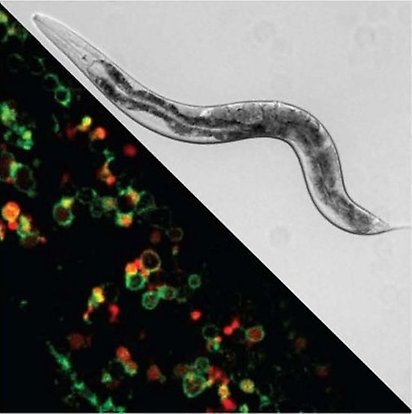Hinas lab

In my research group, we are interested in the mechanisms of RNA interference (RNAi), epigenetics and cell-cell transport of RNA between cells in animals. To be able to easily study these pathways in the context of a whole animal, we are using the nematode Caenorhabditis elegans. In addition to our main line of research, we strive to promote the use of C. elegans as a model organism in Uppsala and Sweden.
Popular science presentation
...
Research projects
Cell biology of RNA interference, intercellular RNA transport and epigenetic inheritance
RNA interference (RNAi), RNA-induced sequence-specific degradation of mRNA, has emerged as a major mechanism of gene regulation in most eukaryotes and has important implications in biomedical research and drug development. Extensive research has led to a relatively detailed understanding of this process in the short time since its discovery. However, a much less explored aspect of RNAi is the uptake and transport of RNAi silencing signals between cells and generations in animals. Intriguingly, recent studies suggest that this represents a new means of intercellular and intergenerational communication, which may be of importance for example during stressful conditions. In some organisms, such as the nematode Caenorhabditis elegans, RNAi uptake and spreading occurs with high efficiency. By taking advantage of the many molecular and genetic tools available for C. elegans, a number of proteins required for RNA transport has been discovered.
From our previous studies, we know that the SID-5 protein is required for cell-cell transport of RNAi silencing signals in C. elegans and that it localizes to late endosomes/multivesicular bodies (Hinas, Wright and Hunter, 2012). Using a membrane yeast-two-hybrid screen, we subsequently identified several putative SID-5 interacting proteins, for example the conserved membrane fusion SNARE protein SEC-22, which negatively regulates RNAi efficiency (Zhao, Holmgren and Hinas, 2017). Current research is focused on further analysis of the identified SID-5 interacting proteins and their roles in RNAi and RNA transport. Recently, this has brought our attention to the effects of stress on epigenetic inheritance of gene expression.
In addition to the role of SID-5 interacting proteins in RNAi, RNA transport and epigenetics, we are currently involved in two projects regarding the use of C. elegans as a model for parasitic worms and their resistance to anthelmintics. One of these projects is a collaboration with Dr. Eva Tydén at the Swedish University of Agricultural Sciences (SLU), supported by Formas, and the other is part of a research environment grant from the Swedish Research Council (Vetenskapsrådet). We also collaborate with other groups interested in using C. elegans as a model for their research questions.
Group members
Publications
Part of PLOS ONE, 2024
- DOI for Gene co-expression network analysis reveal core responsive genes in Parascaris univalens tissues following ivermectin exposure
- Download full text (pdf) of Gene co-expression network analysis reveal core responsive genes in Parascaris univalens tissues following ivermectin exposure
Part of PLOS ONE, 2023
- DOI for Transcriptomics of ivermectin response in Caenorhabditis elegans: Integrating abamectin quantitative trait loci and comparison to the Ivermectin-exposed DA1316 strain
- Download full text (pdf) of Transcriptomics of ivermectin response in Caenorhabditis elegans: Integrating abamectin quantitative trait loci and comparison to the Ivermectin-exposed DA1316 strain
Part of Parasites & Vectors, 2022
- DOI for Ivermectin-induced gene expression changes in adult Parascaris univalens and Caenorhabditis elegans: a comparative approach to study anthelminthic metabolism and resistance in vitro
- Download full text (pdf) of Ivermectin-induced gene expression changes in adult Parascaris univalens and Caenorhabditis elegans: a comparative approach to study anthelminthic metabolism and resistance in vitro
Part of Evolution Letters, p. 207-216, 2019
- DOI for Experimentally reduced insulin/IGF‐1 signaling in adulthood extends lifespan of parents and improves Darwinian fitness of their offspring
- Download full text (pdf) of Experimentally reduced insulin/IGF‐1 signaling in adulthood extends lifespan of parents and improves Darwinian fitness of their offspring
Part of Proceedings of the Royal Society of London. Biological Sciences, 2017
Part of International journal of experimental pathology (Print), 2017
Part of RNA, p. 297-307, 2017
- DOI for The conserved SNARE SEC-22 localizes to late endosomes and negatively regulates RNA interference in Caenorhabditis elegans
- Download full text (pdf) of The conserved SNARE SEC-22 localizes to late endosomes and negatively regulates RNA interference in Caenorhabditis elegans
Part of Scientific Reports, 2016
- DOI for Nematodes join the family of chondroitin sulfate-synthesizing organisms: Identification of an active chondroitin sulfotransferase in Caenorhabditis elegans
- Download full text (pdf) of Nematodes join the family of chondroitin sulfate-synthesizing organisms: Identification of an active chondroitin sulfotransferase in Caenorhabditis elegans
SID-5 Is an Endosome-Associated Protein Required for Efficient Systemic RNAi in C. elegans
Part of Current Biology, p. 1938-1943, 2012
Part of Genome Research, p. 888-899, 2008
Part of Nucleic Acids Research, p. 6714-6726, 2007
Treasure hunt in an amoeba: non-coding RNAs in Dictyostelium discoideum.
Part of Current Genetics, p. 141-159, 2007
Part of Nucleic Acids Research, p. 773-784, 2006
Part of Eukaryotic Cell, p. 924-934, 2006
People
Andrea Hinas, PhD
Group leader
Védís Mist Eyju Agnadóttir
GROUP ALUMNI
Shweta Roy, postdoc
Nouha Abdelaziz, MSc student
Joel Pålsson, BSc student
Darío Sánchez Martín, MSc, Project assistant
Ida Isolehto, Master thesis student
Erik Gudmunds, Master thesis student
Benjamin Holmgren, PhD student
Yani Zhao, PhD student
Linnéa Bäckström, Master thesis student
Dirui Li, postdoctoral fellow

